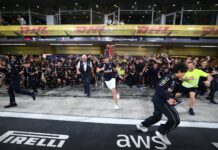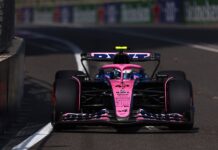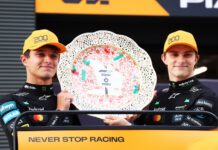Following two fast and historic circuits in the heartland of Europe, Spa and Monza, Formula One is now headed for a complete contrast: the ultra-modern Singapore street circuit, which is the only race on the calendar run at night under street lamps. To suit the stop-start nature of the track, Pirelli has selected the P Zero Red supersoft tyre – the softest tyre in the range – and the P Zero White medium.
As well as the fact that the race is run at night, with the teams all sticking to a European time schedule, there are a number of other factors that make the Marina Bay circuit unique. In terms of duration, this is usually the longest race of the year as it often comes close to the two-hour time limit, which means that the cars carry the heaviest fuel load of the season. It’s also one of the most humid races of the year, and statistically there’s a high chance of a safety car intervention. All these elements affect tyre wear and degradation as well as strategy.
Paul Hembery: “The tyres we are bringing to Singapore this year represent a change from last year, when we went for supersoft and soft. This is because the tyres are generally softer across the board this year in order to maximise performance and grip. Singapore is quite bumpy – a typical feature of street circuits – and there’s lots of street furniture such as painted white lines and manholes that compromise grip and traction. We’re racing at night, which presents a unique set of parameters for the tyres to deal with when it comes to the way that track and ambient temperatures evolve. The cars also carry the heaviest fuel load of the year, which again has a direct effect on tyre wear and degradation. It’s a long race, and that gives the teams plenty of scope to come up with some interesting strategies at what is a truly spectacular event in every sense. We’ve always been made to feel incredibly welcome at Singapore, which is probably the most spectacular event of the year in terms of the whole show that is put on for the public. Our aim as always is to contribute to that show by providing tyres with exactly the right compromise between performance and degradation in order to guarantee close racing.”
Jean Alesi: “I’ve never raced at Singapore but I went over there to watch the grand prix two years ago. I can only describe it as an amazing sight: what the organisers have achieved takes your breath away. And it’s fantastic to watch on TV too as a pure visual spectacle. From what I could see it’s a race that is hard on the drivers and cars but maybe less so on the tyres: the average speed is not so high and there’s a lot of stop and start with quite low grip, which are all conditions that generally do not punish the tyres too much. For the drivers though it’s a different story: the high temperatures, humidity, and the sheer length of the race demand a lot physically. Spa and Monza, which we’ve just had, are two tracks that are very hard on tyres. Now we go to something that’s completely different and I think it’s going to be interesting to see what sort of strategies the teams can formulate in Singapore. With the supersoft and medium tyres, there is plenty of opportunity to try something different, and that’s a fascinating part of modern grand prix racing.”
The circuit from a tyre point of view:
Traction is fundamental as Singapore contains the second-highest number of corners of the year (23). The asphalt tends to be bumpy and slippery, with grip compromised by street markings and manholes. But the cars can still generate 4.3g under braking despite the lack of grip.
The humidity levels at Singapore are between 75% and 90%, which can often lead to rain. Consequently, there is a high chance that the Cinturato Green intermediates or Cinturato Blue full wet tyres could also be used.
Singapore has one of the highest pit stop times of the year, due to a lower pit lane speed limit than most races (60kph) and a 404-metre pit lane, which has an impact on the strategy as well.
Further information about Singapore and the demands it places on tyres, as well as more information about Pirelli’s intermediate and full wet tyres, can be found on a 3D animated video starring Pirelli’s Racing Manager Mario Isola. This is copyright-free for media use on Pirelli’s Formula One website:www.pirelli.com/f1pressarea
Technical tyre notes:
As well as being a long race, fuel consumption per kilometre is one of the highest of the year due to the stop-start nature of the circuit. Around half the lap is spent on full throttle, but there are also several braking areas.
All the podium finishers last year used a two-stop strategy. Sebastian Vettel won the race from third on the grid with the P Zero Red supersoft tyre and then completed two stints on the P Zero Yellow soft tyre. Jenson Button finished second using exactly the same strategy. All of the top 10 on the grid started the race with the supersoft compound.
Race strategy at Singapore has to be very flexible in order to take into account the high safety car probability (there were two safety car periods last year). Safety car periods mean that some drivers can effectively bank a ‘free’ pit stop, and it also slows down overall wear and degradation as lap times are much slower.
The tyre choices so far:
| PZero Red | PZero Yellow | PZero White | PZero Orange | |
| Australia | Supersoft | Medium | ||
| Malaysia | Medium | Hard | ||
| China | Soft | Medium | ||
| Bahrain | Medium | Hard | ||
| Spain | Medium | Hard | ||
| Monaco | Supersoft | Soft | ||
| Canada | Supersoft | Medium | ||
| Great Britain | Medium | Hard | ||
| Germany | Soft | Medium | ||
| Hungary | Soft | Medium | ||
| Belgium | Medium | Hard | ||
| Italy | Medium | Hard | ||
| Singapore | Supersoft | Medium |
Meet the Pirelli F1 Team: Luigi De Candia, IT Project Manager
Luigi, known as Gigi, is one of the most indispensable people in the Pirelli motorhome. He looks after all aspects of the Italian firm’s IT on-event, from setting up the RTS (Racing Tyre System) that acts as a central hub for all information to dealing with individual problems. He wrote most of the bespoke software that Pirelli uses for tyre management, and often finds himself updating this or adding to it during a race weekend as requests for additional functionality come in. Gigi studied mechanical engineering originally but then switched to IT, although he points out that in his line of work, most experience is actually acquired on the job. He should know, having worked for Pirelli for more than 10 years on a massive variety of projects. “Originally I was writing software for production processes, then by chance the need arose to create some software that could be used for motorsport. My first motorsport project with Pirelli was WRC in 2004, then I also worked in GT racing, Grand Am and GP3 before coming over to Formula One with the rest of the team in 2011.”
Like most people who work in Formula One, Gigi doesn’t get much free time to call his own. But when he does, he enjoys spending time with his three-year-old daughter and meeting his friends to watch the other love of his life: Juventus…
Other news from Pirelli:
For the seventh consecutive year, Pirelli has been named as leader in the Auto Components section of the Dow Jones Sustainability Index. The Italian firm scored 85 points compared to an industry average of 51.
Pirelli has claimed its 60th motocross title, thanks to KTM factory riders Antonio Cairoli and Jeffrey Herlings, who sealed the MX1 and MX2 titles respectively at the final round of the series in Lierop close to Eindhoven.
Pirelli has confirmed a new partnership with the Dutch-based International Supercar Challenge to supply tyres from its Didcot-based Motorsport Technical Centre. This three-year contract brings the Italian firm’s involvement with motorsport championships across the globe to over 250.
Pirelli Media



















